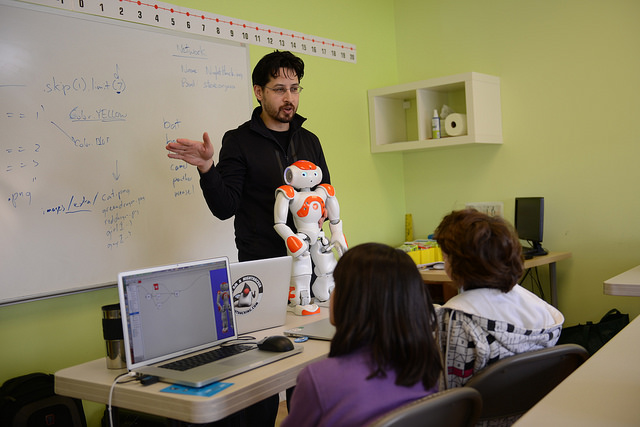![1. Nao robots by Kai Schreiber from Jersey City, USA (be seeing you Uploaded by PDTillman) [CC BY-SA 2.0 (https://creativecommons.org/licenses/by-sa/2.0)], via Wikimedia Commons](http://www.myenglishlanguage.com/wp-content/uploads/2016/02/nao-robot-teachers.jpg)
British academics have programmed a child-sized robot to teach languages to children. The design has been piloted in the UK and is now being tried out across Europe. The Nao robot teachers are designed to look friendly and approachable and react to children’s moods and facial expressions.
Originally designed to teach History and Maths, the dwarf robots are currently being used in Germany to teach language skills to refugee children as part of the L2TOR language project.
Experts believe that robot teachers will soon become a regular part of the general school education system. Read more to find out about the robot teachers currently being used in Europe’s language classrooms – and how robots could revolutionise education and language learning.
Robot teachers more effective than computers
Tony Belpaeme, Professor of Cognitive Systems and Robotics at Plymouth University has been leading a team in robotics. The team started out using robots to support children who had been hospitalised and they found that the robots were effective educational tools in this setting.
Professor Belpaeme explains: “We’ve been doing research with social robots that interact in a human-like way… if a robot explains something , you’re going to take away more from it than the same information from a computer or tablet”.
Robots are thought to be more useful as teaching aids than computers because they can mimic human response.
Computers offer less opportunity to interact and it has been found that interacting with robots activates social areas of the brain which are not activated when children use computers.
Human ‘social brain’ prefers robot interaction
The reason behind this greater response to interactions with robot teachers than with computers seems to be because humans react more strongly to social stimuli.
We have evolved to be a social species, so our ‘social brain’ is naturally programmed to pay more attention to a human-like robot than a computer screen.
The robot teachers were initially used to teach Mathematics and History in schools but now the programme will be rolled out to include languages.
The robots were set to be used in the Netherlands and Germany to help Turkish children learn the language of their new home.
However, now the programme is being used to teach refugee children, particularly Syrian children aged 4-5. It is hoped that at this age they will pick up their new language quickly.
The L2TOR project
The robots are part of L2TOR (pronounced ‘El Tutor’), a project funded by the European Union to develop artificial intelligent teachers for educating preschool children.
The robot teachers used in Germany in the three-year study stand just under 2 feet tall and provide one-on-one lessons to mainly Syrian children.
The Nao robots are made by Paris-based company, Aldebaran Robotics and cost over £5,000 each. They are programmed to act as ‘real’ as possible, with human-like responses, including deliberate mistakes, to make them seem more realistic.
The only issue with the robot teachers is that they rely on a series of key words, so they cannot cope with free exchanges of ideas and struggle with conversation.
Robot teachers in the future
Sir Anthony Seldon, the former head teacher of Wellington College, calls the prospect of robot teachers “the greatest revolution in education since the printing press“.
Seldon believes that robot teachers will “change the face of schooling for all” by enabling all children from every walk of life to have a better education than any available today.
Moving on from using robots to teach the basics of a new language, Seldon thinks robot teachers will soon be found in all schools and used as a regular part of the education system.
Computer programs will be able to learn students’ individual learning styles and tailor lessons to suit their precise needs. Each student will work at their own pace, as everyone will benefit from customised lesson plans.
Students might be better in one school subject than another, so their lessons will be personalised to suit their exact level in each lesson.
The same robot teacher can follow a child through their schooling, learning their individual preferences, motivations and difficulties. This will help the robot teacher to match the child’s speed of learning, adapting to their needs.
Of course, this same style of learning using artificial intelligence could apply to adults learning languages or any other subject in later life.
Revolutions in education
Sir Anthony Seldon is writing a book called The Fourth Revolution, which will discuss the most important changes that have taken place in the world of education.
The first ‘revolution’ was the sharing of knowledge by our ancestors, the second was the the creation of organised learning institutions such as universities, and the third was the development of the printing press. According to Seldon, robot teachers will be the fourth revolution in education.
There are many other important, some would say revolutionary, events in the British education system.
One important event was the introduction by the Victorians of mandatory schooling for all children until the age of 10 (raised to the age of 12 in 1889). Free schooling for all was introduced in Britain in 1891. In 1878, the University of London became the first university in the UK to admit women to its degrees.
Human teachers in the future
Although robot teachers will herald a new age in education, they will not make human teachers redundant.
Seldon says: “The teacher will no longer be the person standing up at the front. Marking and assessment and preparation of lessons will be done by the computers. Teachers will be the organisers, stucturers, discipliners”.
So there will still be a role for human teachers in future schools. Though for how long? If robots continue to advance at such a fast pace, humans may soon be unnecessary to the education system.
Share your thoughts on robot teachers
What do you think about the robot teachers in general? Can they replace a human teacher effectively?
Would pupils respect a robot teacher? Could future robot teachers cope with discipline problems?
What do you think about the Nao robot teachers? Do you think they are better than humans for students for learning languages?
Would you use a robot to help you learn English or another language?
Do you think robots should be used to help adults learn languages and other subjects?
Let us know your thoughts in the comments!
Attributions
- Nao robot demo, Jaume University. Image by Kai Schreiber from Jersey City, USA (be seeing you Uploaded by PDTillman) [CC BY-SA 2.0], via Wikimedia Commons
- Raspberry Pi and NAO Kids Workshop by Stephen Chin, via Flickr [CC BY 2.0]


